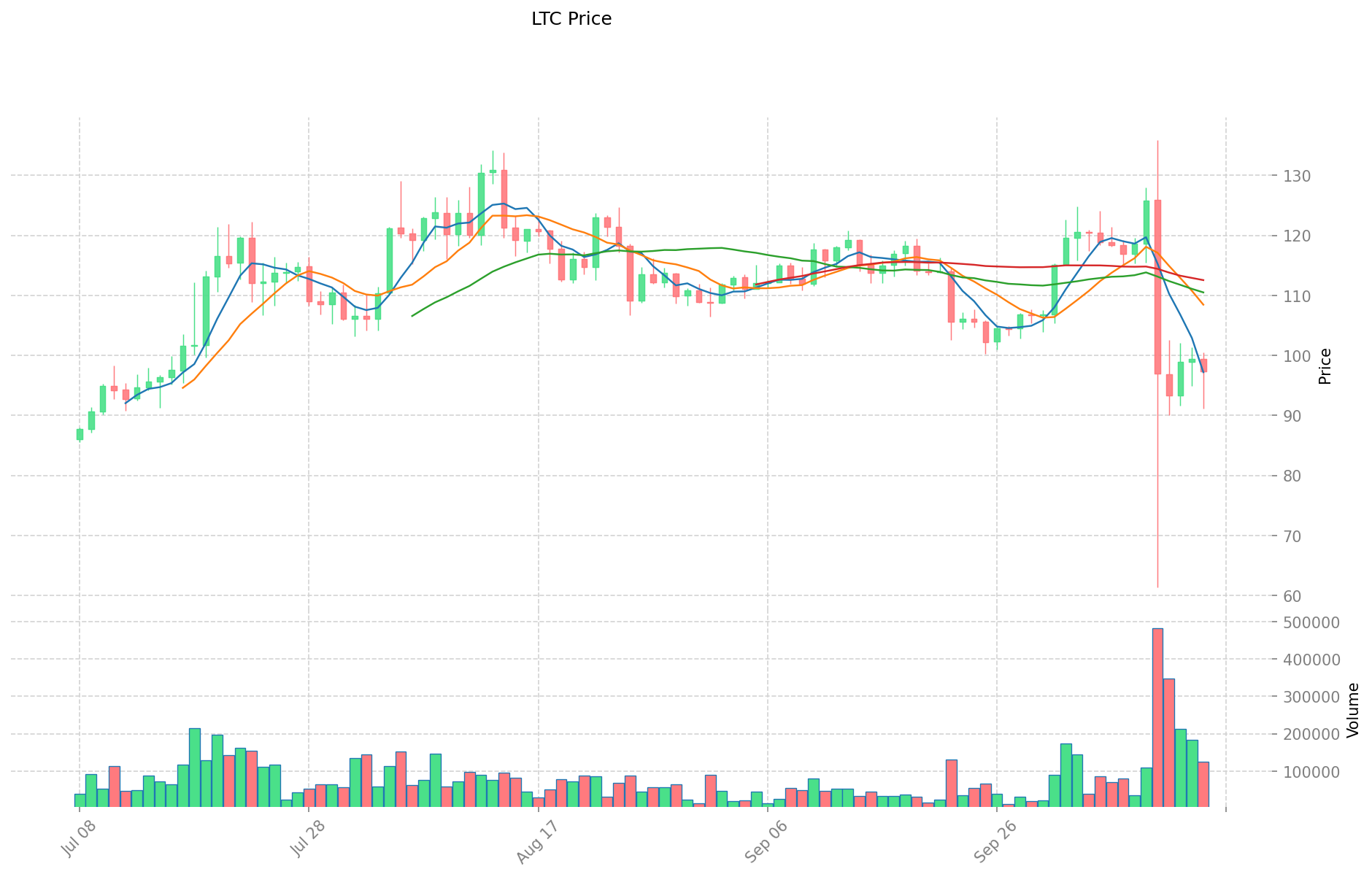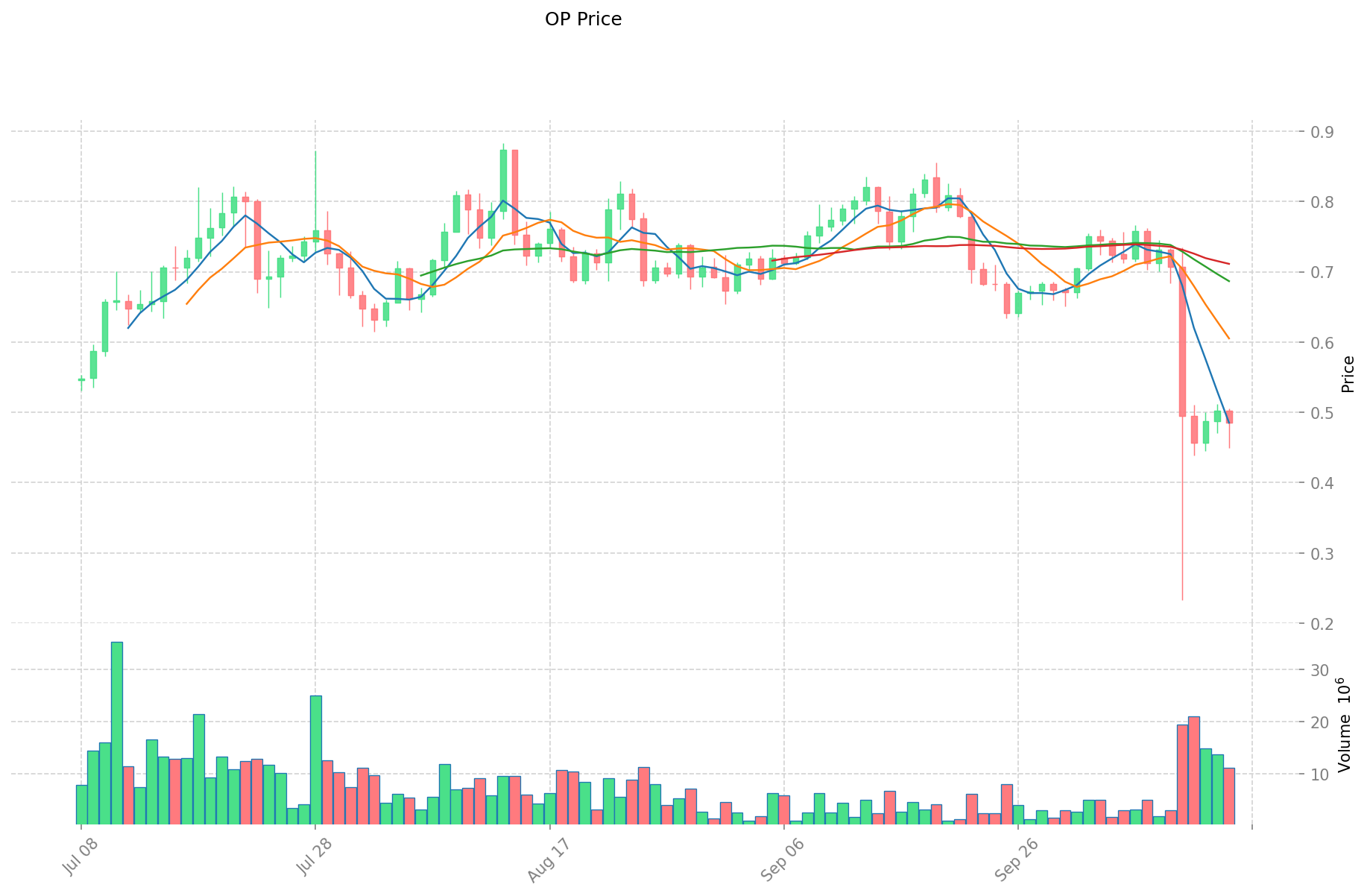LTC vs OP: Comparing Litecoin and Optimism in the Crypto Ecosystem
Introduction: LTC vs OP Investment Comparison
In the cryptocurrency market, Litecoin vs Optimism comparison has always been an unavoidable topic for investors. The two not only have significant differences in market cap ranking, application scenarios, and price performance, but also represent different cryptocurrency asset positioning.
Litecoin (LTC): Since its launch in 2011, it has gained market recognition for its fast transaction confirmation speed.
Optimism (OP): Since its introduction in 2022, it has been hailed as a low-cost, lightning-fast Ethereum Layer 2 blockchain, addressing the practical needs of developers and users.
This article will comprehensively analyze the investment value comparison between LTC and OP, focusing on historical price trends, supply mechanisms, institutional adoption, technical ecosystems, and future predictions, and attempt to answer the question investors care about most:
"Which is the better buy right now?"
I. Price History Comparison and Current Market Status
Litecoin (LTC) and Optimism (OP) Historical Price Trends
- 2021: Litecoin reached its all-time high of $410.26 due to the overall crypto market bull run.
- 2024: Optimism hit its record high of $4.84 in March, likely driven by increased adoption of Layer 2 solutions.
- Comparative analysis: During the recent market cycle, Litecoin fell from its peak of $410.26 to a low of $97.27, while Optimism demonstrated greater volatility, dropping from $4.84 to $0.34081.
Current Market Situation (2025-10-15)
- Litecoin current price: $97.27
- Optimism current price: $0.4798
- 24-hour trading volume: $11,553,419 (LTC) vs $4,694,961 (OP)
- Market Sentiment Index (Fear & Greed Index): 34 (Fear)
Click to view real-time prices:
- Check LTC current price Market Price
- Check OP current price Market Price


Impact Factors on LTC vs OP Investment Value
Supply Mechanism Comparison (Tokenomics)
- LTC: Fixed supply cap of 84 million coins with halving mechanism similar to Bitcoin
- OP: Token distribution primarily to core developers and institutions, with controlled release schedule
- 📌 Historical Pattern: LTC's halving events historically precede price appreciation cycles, while OP's value depends on project fund usage and institutional selling pressure.
Institutional Adoption and Market Applications
- Institutional Holdings: LTC gaining stronger institutional interest with ETF approval probability exceeding 90%
- Enterprise Adoption: LTC positioned as "digital silver" with longer history in payment applications, while OP serves as Ethereum's Layer 2 scaling solution
- Regulatory Attitudes: LTC benefits from regulatory clarity as one of the oldest altcoins, while OP operates within Ethereum's regulatory framework
Technical Development and Ecosystem Building
- LTC Technical Upgrades: Benefits from being one of the oldest and most established altcoins in circulation since 2011
- OP Technical Development: Functions as an Ethereum-based Layer 2 scaling solution, addressing Ethereum's network congestion issues
- Ecosystem Comparison: LTC leveraged in altcoin season rallies, while OP is deeply integrated into Ethereum's ecosystem with TVL growth potential
Macroeconomic Factors and Market Cycles
- Performance During Inflation: LTC often viewed as "crypto silver" to Bitcoin's "crypto gold" during inflation periods
- Monetary Policy Impact: Both influenced by broader crypto market cycles, with LTC particularly sensitive to altcoin seasonality
- Geopolitical Factors: LTC may benefit from broader US crypto policy developments, while OP's growth correlates with Ethereum adoption trends and Layer 2 solution demand
III. 2025-2030 Price Prediction: LTC vs OP
Short-term Prediction (2025)
- LTC: Conservative $51.46 - $97.09 | Optimistic $97.09 - $106.80
- OP: Conservative $0.31 - $0.48 | Optimistic $0.48 - $0.62
Mid-term Prediction (2027)
- LTC may enter a growth phase, with estimated prices ranging from $85.63 to $121.03
- OP may enter a growth phase, with estimated prices ranging from $0.51 to $0.62
- Key drivers: Institutional capital inflow, ETFs, ecosystem development
Long-term Prediction (2030)
- LTC: Base scenario $116.77 - $145.96 | Optimistic scenario $145.96 - $195.59
- OP: Base scenario $0.71 - $0.74 | Optimistic scenario $0.74 - $1.06
Disclaimer: The above predictions are based on historical data and market analysis. Cryptocurrency markets are highly volatile and subject to rapid changes. These projections should not be considered as financial advice or guarantees of future performance. Always conduct your own research and consult with a financial advisor before making investment decisions.
LTC:
| 年份 | 预测最高价 | 预测平均价格 | 预测最低价 | 涨跌幅 |
|---|---|---|---|---|
| 2025 | 106.799 | 97.09 | 51.4577 | 0 |
| 2026 | 126.41118 | 101.9445 | 60.147255 | 4 |
| 2027 | 121.0285104 | 114.17784 | 85.63338 | 17 |
| 2028 | 165.820477032 | 117.6031752 | 79.970159136 | 20 |
| 2029 | 150.21453568296 | 141.711826116 | 124.70640698208 | 45 |
| 2030 | 195.5906624053032 | 145.96318089948 | 116.770544719584 | 50 |
OP:
| 年份 | 预测最高价 | 预测平均价格 | 预测最低价 | 涨跌幅 |
|---|---|---|---|---|
| 2025 | 0.62205 | 0.4785 | 0.30624 | 0 |
| 2026 | 0.594297 | 0.550275 | 0.50075025 | 14 |
| 2027 | 0.61806888 | 0.572286 | 0.50933454 | 18 |
| 2028 | 0.6665987328 | 0.59517744 | 0.3690100128 | 23 |
| 2029 | 0.85169891664 | 0.6308880864 | 0.334370685792 | 31 |
| 2030 | 1.0600497071736 | 0.74129350152 | 0.7116417614592 | 53 |
IV. Investment Strategy Comparison: LTC vs OP
Long-term vs Short-term Investment Strategy
- LTC: Suitable for investors focused on payment scenarios and established altcoin potential
- OP: Suitable for investors interested in Ethereum ecosystem growth and Layer 2 scaling solutions
Risk Management and Asset Allocation
- Conservative investors: LTC: 70% vs OP: 30%
- Aggressive investors: LTC: 40% vs OP: 60%
- Hedging tools: Stablecoin allocation, options, cross-currency portfolio
V. Potential Risk Comparison
Market Risk
- LTC: Vulnerability to overall cryptocurrency market volatility
- OP: Dependence on Ethereum's performance and Layer 2 adoption rates
Technical Risk
- LTC: Scalability, network stability
- OP: Reliance on Ethereum's technical developments, potential smart contract vulnerabilities
Regulatory Risk
- Global regulatory policies may impact both differently, with LTC potentially benefiting from its longer history and established status
VI. Conclusion: Which Is the Better Buy?
📌 Investment Value Summary:
- LTC advantages: Established history, potential institutional adoption, ETF prospects
- OP advantages: Ethereum ecosystem integration, Layer 2 scaling solution, growth potential
✅ Investment Advice:
- New investors: Consider a balanced approach, leaning towards LTC for its established status
- Experienced investors: Explore OP for higher growth potential, while maintaining LTC exposure
- Institutional investors: Focus on LTC for potential ETF opportunities and regulatory clarity
⚠️ Risk Warning: Cryptocurrency markets are highly volatile. This article does not constitute investment advice. None
FAQ
Q1: What are the main differences between Litecoin (LTC) and Optimism (OP)? A: Litecoin is an established cryptocurrency launched in 2011, often referred to as "digital silver," with a focus on fast transactions. Optimism is a newer Layer 2 scaling solution for Ethereum, introduced in 2022, aimed at improving Ethereum's speed and reducing transaction costs.
Q2: How do the supply mechanisms of LTC and OP compare? A: LTC has a fixed supply cap of 84 million coins with a halving mechanism similar to Bitcoin. OP's token distribution is primarily to core developers and institutions, with a controlled release schedule.
Q3: Which cryptocurrency has shown better price performance recently? A: Based on recent market cycles, Optimism (OP) has demonstrated greater volatility, while Litecoin (LTC) has shown more stability. However, past performance does not guarantee future results.
Q4: What are the key factors influencing the investment value of LTC and OP? A: Key factors include institutional adoption, technical development, ecosystem building, macroeconomic conditions, and regulatory attitudes. LTC benefits from its established history and potential ETF approval, while OP's value is tied to Ethereum's ecosystem growth and Layer 2 adoption.
Q5: How do the long-term price predictions for LTC and OP compare? A: By 2030, LTC is predicted to range from $116.77 to $195.59 in optimistic scenarios, while OP is expected to range from $0.71 to $1.06. However, these predictions are speculative and subject to market conditions.
Q6: Which cryptocurrency might be better suited for different types of investors? A: LTC may be more suitable for conservative investors and those interested in established altcoins with payment use cases. OP might appeal to investors focused on Ethereum ecosystem growth and Layer 2 scaling solutions. New investors might consider a balanced approach, while experienced investors could explore OP for higher growth potential.
Q7: What are the main risks associated with investing in LTC and OP? A: Both face market risks related to cryptocurrency volatility. LTC has technical risks around scalability and network stability, while OP faces risks related to Ethereum's development and potential smart contract vulnerabilities. Regulatory risks apply to both, though LTC may have an advantage due to its longer history.
Share
Content